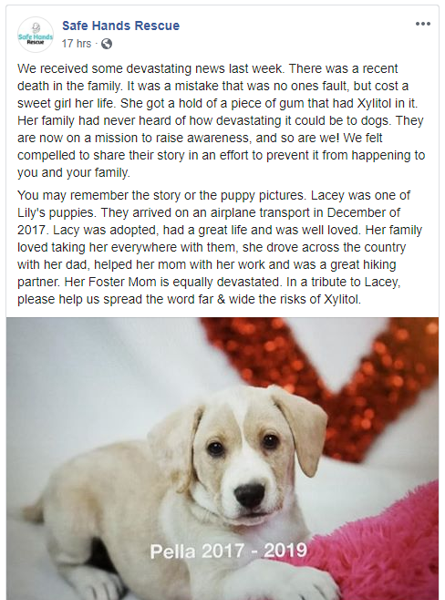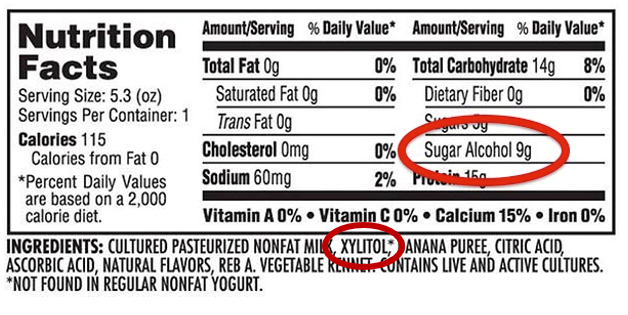The Dangers of Xylitol
What You Need to Know
 We were saddened to see the recent Facebook update from Safe Hands Rescue that there had been an unexpected death in their family because of xylitol. This tragedy served as an important reminder that many dog lovers are unaware of the life-threatening effects that this sugar-free sweetener has on dogs. Worse yet, it’s hidden in many everyday items found throughout your home.
We were saddened to see the recent Facebook update from Safe Hands Rescue that there had been an unexpected death in their family because of xylitol. This tragedy served as an important reminder that many dog lovers are unaware of the life-threatening effects that this sugar-free sweetener has on dogs. Worse yet, it’s hidden in many everyday items found throughout your home.
In memory of sweet Lacey, her devastated family and Safe Hands Rescue are on a mission to raise awareness of the dangers of xylitol. We wanted to support their efforts and help spread the word.
What Is Xylitol?
Xylitol is a type of naturally occurring sugar alcohol. It looks and tastes like plain sugar, but it comes with 40% fewer calories and doesn’t raise your blood sugar. This makes it a popular sweetener for sugar-free products, especially candy, gum, and diabetic-friendly foods.
Unfortunately, while xylitol is usually well-tolerated in humans, it’s extremely toxic for dogs. That’s because ingesting even tiny amounts triggers a rapid and massive insulin release in a dog’s pancreas, which causes their blood sugar to drop to dangerously low levels within 10-60 minutes. In fact, a dog can become comatose within 15-20 minutes after eating xylitol and, without immediate medical attention, experience liver failure, and even death.
Perhaps the scariest thing about xylitol is how little a dog needs to consume to be at risk – only about 50 milligrams per pound of body weight. And, since many common brands of gum can contain 1 gram in a single piece, that means a dog only needs to eat a piece or two to experience life-threatening side effects.
Products Containing Xylitol
Xylitol’s popularity has only increased over the years, and so have the number of poisoning cases in dogs. In 2009, the Pet Poison Hotline reported approximately 300. But, by 2015, those numbers jumped to 2,800. Of all the xylitol calls they receive, 80% of xylitol calls are from dogs ingesting chewing gum. However, that’s not the only product that contains this dangerous ingredient.
A few common items containing xylitol include:
 Gums, candies, and breath mints
Gums, candies, and breath mints- Ketchup
- Peanut butter
- Protein bars
- Pudding snacks
- Baked goods
- Mouthwash and toothpaste
- Lotions and deodorants
- Laxatives and digestive aids
- Nasal sprays and allergy medicines
- Cough syrup
- Chewable or gummy vitamins and supplements
- Human medications, especially sleep aids, pain relievers, and antipsychotic drugs
To keep your dog as safe as possible, keep items made for humans safely out of reach and read labels carefully before sharing anything from your pantry.
What to Do If Your Dog Consumes Xylitol
If you think your dog ingested xylitol, DON’T WAIT to contact your vet or Pet Poison Helpline 1-800-213-6680 – even if they aren’t showing symptoms. Your dog’s best chance of surviving xylitol poisoning is through fast and aggressive treatment.
Signs of xylitol poisoning typically develop within 15-30 minutes and include:
- Weakness
- Vomiting
- Lethargy or depression
- Difficulty walking or standing
- Tremors or seizures
- Coma
Remember, even seemingly small amounts of xylitol can have devastating effects on your dog. In memory of Lacey, let’s help her family and Safe Hands Rescue spread to word about the risks of xylitol to avoid future tragedies.

